BRITISH WEST AFRICAN CURRENCY BOARDS INTRODUCTION OF PAPER MONEY
The British West African Currency Board was constituted in 1912 to control the supply of currency to the British West African Colonies; these now constitute Nigeria, Ghana, Sierra Leone and Gambia. Whereas various silver and other metal coins had been in use in West Africa since the late eighteenth century; the coastline was unusual in the array of traditional forms of currency being used. These included cowrie shells, manillas, gold dust, bars iron) and cases of gin!
The criteria for an ideal currency is that it is hardy, long lasting, easy to count, difficult to counterfeit, it is portable, durable and easy to recognize. Consequently there were few rivals to precious metals except cowrie shells! They represented the shillings and pence of the West African culture, the pounds being represented by higher value merchandise such as gold. By the nineteen twenties cowries had virtually disappeared from main trade, the British silver coin was accepted together with 1/10 penny and penny. Manillas which are pieces of copper in horseshoe shaped form were probably introduced to West Africa by the Portuguese in the sixteenth century; they came to trade goods in exchange for slaves and ivory and found their bracelets or manillas well accepted. At that time 12-15 brass manillas purchased one slave. Gin might appear unusual as a currency but cases of gin were well accepted in East And Central Nigeria being a good investment since the government continued to increase excise taxes and thus the price of gin went up.
Based on the fact that by 1910 the amount of silver coinage in circulation in the West African Colonies Nigeria, Gold Coast (Ghana), Sierra Leone and Gambia was almost equivalent to that in circulation in the United Kingdom and given the fact that cash transactions had practically replaced barter the British Government requested a committee to look into the best currency policy for the West African Colonies. The Board recommended issuing paper money determined that the first paper issues bearing the name of the Currency Board would be a 2/- ,10/- and 20 shillings. One centre Lagos would initially be used for circulation.
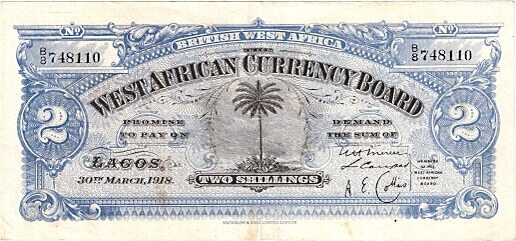
BRITISH WEST AFRICA TWO SHILLINGS PICK 2B 30th March 1918
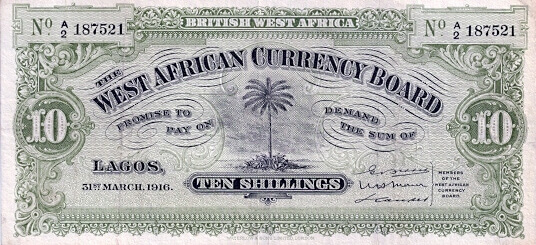
TEN SHILLINGS PICK 4A 31ST MARCH 1916
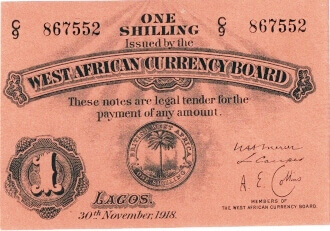
BRITISH WEST AFRICAN ONE SHILLING PICK 1a DECEMBER 1918
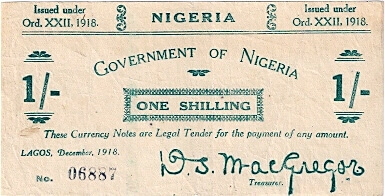
NIGERIA ONE SHILLING EMERGENCY ISSUE PICK 1 DECEMBER 1918
The notes printed by Waterloo were first issued 11th July 1916 and two months later were also issued in Gold Coast (Ghana) and Sierra Leone.
The West African Currency Board was dogged during the initial years of currency circulation in maintaining adequate supplies. Besides the regular fluctuations in agricultural crops cocoa, groundnuts, palm oil and palm kernels the 1914 world war abruptly affected commodity exports. In 1918 the board could not meet the demand for silver coin based on the rapid turn around in the economy after the first world war. The Bank of England authorized the printing of 21 million salmon one shilling replacement notes as an alternative.
Before these supplies could reach Nigeria, the Nigerian Authorities were forced to issue their own emergency currency in 1918.
Three values were produced 1/-,10/- and 20/-. As soon as the salmon notes shown above arrived the Nigerian notes were withdrawn hence they are extremely scarce. As early as 1919 it was realized that at the present stage of development West Africa was not ready for paper currency. Although the one pound note was popular with Europeans and in the larger towns, the 1/- and 2/- designed for wider use met with dislike from the general public for which they were intended. In addition the 5 pound note with the date 1st March 1919 was issued for use by banks and wealthy people, again lack of use resulted in withdrawal in 1923.
After the poor reception of the 1916-1918 paper money introductions it was not until ten years later that the Board was ready to introduce restyled notes. This was largely driven by the widespread use of forgeries for the existing notes. The new notes were printed on better quality paper, printed on direct plate rather than a lithographic process and a watermark was added to the right hand side. The 1928 series was issued between 1928-1951.
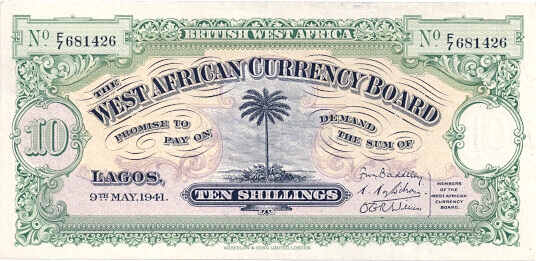
TEN SHILLINGS 9TH MAY 1941 PICK 7b
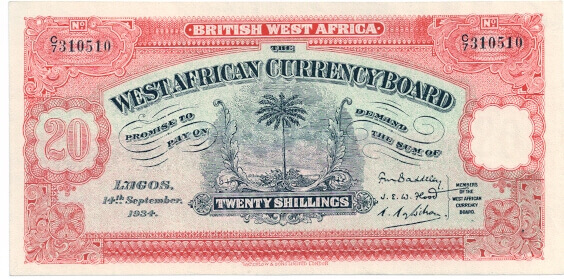
TWENTY SHILLINGS 14th SEPTEMBER 1934 PICK 8a
It was not until the early 1950s that great changes started taking effect in West Africa. Oil was discovered in Nigeria. In the Gold Coast (Ghana) the output of gold manganese and diamonds was increasing and in Sierra Leone large iron ore deposits were opened in addition to the rush for diamonds.
The Currency Board was not immune to these rapid changes fulfilling the increased currency demand by issuing new notes.
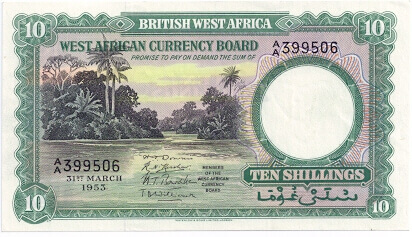
TEN SHILLINGS 31st MARCH 1953 PICK 9
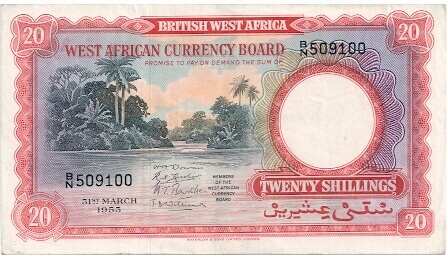
TWENTY SHILLINGS 31st MARCH 1953 PICK 10
Forgeries were further reduced by adding a security thread, native scenes were introduced on the reverse of the notes and the five pound note was reintroduced after an absence of thirty years.

TEN SHILLINGS 31st MARCH 1953 PICK 9
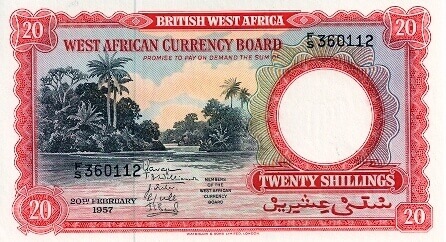
TWENTY SHILLINGS 20TH FEBRUARY 1957 PICK10
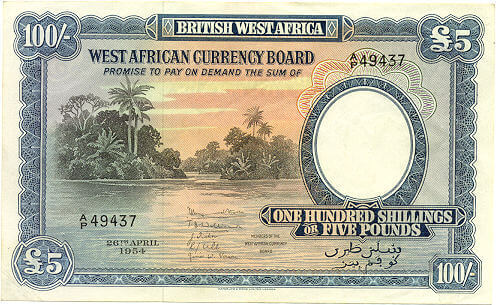
FIVE POUNDS 1954 PICK 11B
The growing pressures for independence meant it was inevitable that the Currency Board would contract. Ghana which had become independent in 1957 entrusted the Bank of Ghana to issue notes in 1958. Nigeria followed soon after the Central Bank of Nigeria opened in July 1959. The currencies of Sierra Leone and Gambia took sometime to be issued. Sierra Leone adopted the Leone from the onset but Gambia (1965) and Nigeria and Ghana initially continued to use the pound.**
**See related article — Pound Banknotes in Post Independence British Africa

